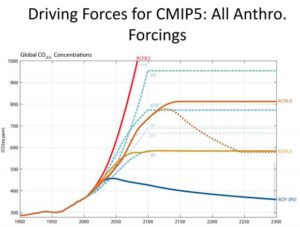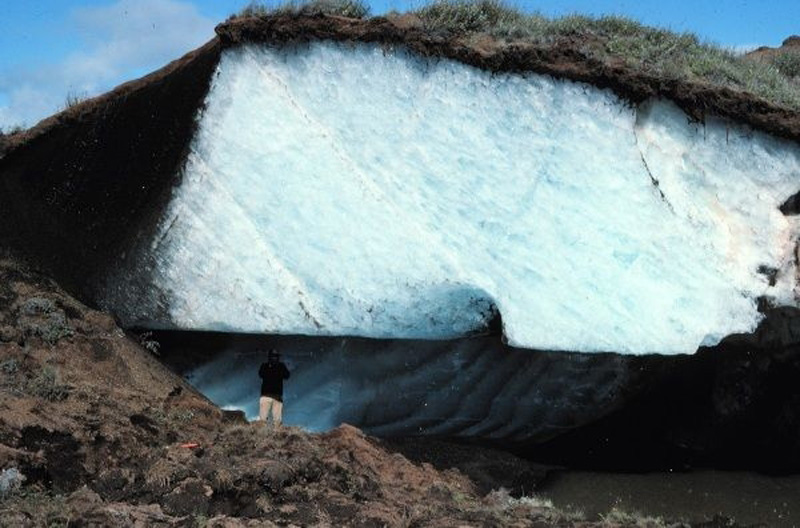Estimating the permafrost-carbon feedback on global warming
Thawing of permafrost and the associated release of carbon constitutes a positive feedback in the climate system
Potsdam Institute: A key uncertainty is the fraction of carbon that might be decomposed under anaerobic conditions – resulting potentially in methane emissions to the atmosphere. Given the high warming potential of methane, the overall magnitude of the permafrost-carbon feedback will depend strongly on this fraction.
Thawing of permafrost and the associated release of carbon constitutes a positive feedback in the climate system, elevating the effect of anthropogenic GHG emissions on global-mean temperatures. Multiple factors have hindered the quantification of this feedback, which was not included in the CMIP3 and C4 MIP generation of AOGCMs and carbon cycle models.
There are considerable uncertainties in the rate and extent of permafrost thaw, the hydrological and vegetation response to permafrost thaw, the decomposition timescales of freshly thawed organic material, the proportion of soil carbon that might be emitted as carbon dioxide via aerobic decomposition or as methane via anaerobic decomposition, and in the magnitude of the high latitude amplification of global warming that will drive permafrost degradation.
Additionally, there are extensive and poorly characterized regional heterogeneities in soil properties, carbon content, and hydrology. Here, we couple a new permafrost module to a reduced complexity carbon-cycle climate model, which allows us to perform a large ensemble of simulations. The ensemble is designed to span the uncertainties listed above and thereby the results provide an estimate of the potential strength of the permafrost-carbon feedback.
For the high CO2 concentration scenario (RCP8.5), 12-52 PgC, or an extra 3-11% above projected net CO2 emissions from land carbon cycle feedbacks, are released by 2100 (68% uncertainty range). This leads to an additional warming of 0.02-0.11°C. Though projected 21st century emissions are relatively modest, ongoing permafrost thaw and slow but steady soil carbon decomposition means that, by 2300, more than half of the potentially vulnerable permafrost carbon stock in the upper 3m of soil layer (600-1000PgC) could be released as CO2, with an extra 1-3% being released as methane.
Our results also suggest that mitigation action in line with the lower scenario RCP3-PD could contain Arctic temperature increase sufficiently that thawing of the permafrost area is limited to 15-30% and the permafrost-carbon induced temperature increase does not exceed 0.01-0.07°C by 2300.
CONCLUSION
The inclusion of a highly simplified, dynamic permafrost module into the reduced complexity carbon-cycle climate model MAGICC has shown how permafrost carbon emissions could affect long-term projections of future temperature change. Our results underline the importance of analyzing long-term consequences of land carbon emissions beyond 2100.
Studies focusing on short time horizons (e.g. Anisimov, 2007) infer a rather small permafrost feedback, in line with our results, while climatic consequences of thawing permafrost soils become clearly apparent after 2100 for the medium and higher RCP scenarios. Even more pronounced than many other components of the Earth System, the permafrost feedback highlights the inert and slow response to human perturbations.
Once unlocked under strong warming, thawing and decomposition of permafrost can release amounts of carbon until 2300 comparable to the historical anthropogenic emissions up to 2000 (approximately 440GtC, cf. Allen et al., 2009).
Under the RCP8.5 scenarios – with cumulative permafrost CO2 emissions of 362 PgC to 705 PgC, this permafrost-carbon feedback could add nearly half a degree warming (0.17-0.94°C) warming from 2200 onwards, albeit in a world that will already be dissimilar to the current one due to global-mean temperature levels near to and possibly in excess of 10°C.
“Cumulative CO2 emissions under RCP8.5 are 26PgC (12-52PgC) by 2100. By 2300, the majority of the permafrost carbon stock could be already released to the atmosphere, with cumulative CO2 emissions being 529 PgC (362-705PgC)“
Our method is however not able to bound a worst-case scenario. For example, if there is extensive thermokarst formation (Walter et al.,2007b; Walter et al., 2006) or subsea permafrost degradation (Shakhova et al., 2010b;Shakhova et al., 2010a), substantial CH4 emissions could result from thawing these high Arctic ecosystems.
For lower scenarios, e.g. the mitigation scenario RCP3-PD, our results suggest that future warming is unlikely to increase Arctic temperatures enough to release a large fraction of the carbon stored in permafrost soils, although up to 22% could be thawed already by 2100. If strong mitigation of emissions is pursued, it seems still possible to prevent the release of large fractions of this permafrost carbon over the coming centuries.
RELATED LINKS

